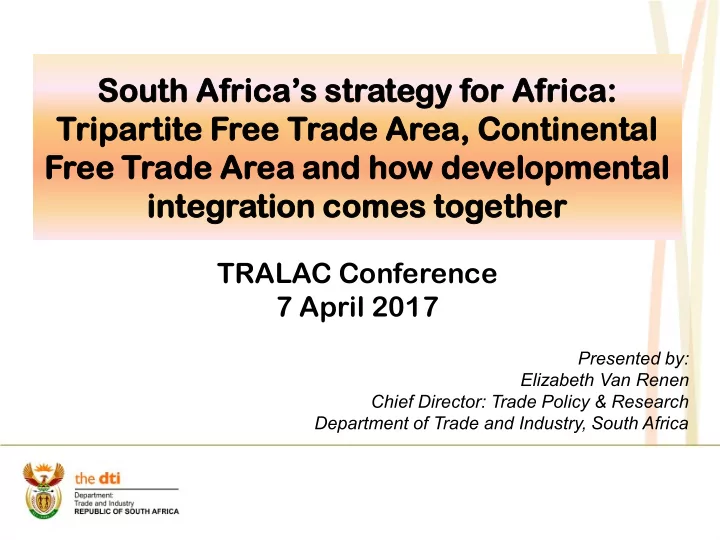

South Africa’s strategy for Africa: ca: Tripartit tite e Free Trade de Area, a, Continenta tal l Free Trade e Area a and how develo lopm pment ental al integratio ion comes together er TRALAC Conference 7 April 2017 Presented by: Elizabeth Van Renen Chief Director: Trade Policy & Research Department of Trade and Industry, South Africa
Africa is important… • …to the world: – 2 nd fastest growing region in the world – average over 2001-2014 >5% – Enormous reserves of natural resources and arable land • …to Africa: – Intra-regional trade ±16% – BUT: for most countries other African countries are by far the 2 nd most important export market – Intra-Africa trade is diversified and growing – Intra-Africa investment grew at 32.5% compound rate since 2007 • …to South Africa: – Leading export destination for SA – SA X to rest of Africa: R9.7 bn in 1994 to >R300 bn in 2015 – SA M from rest of Africa: R3 bn in 1994 to R114 bn in 2015 (peaked at R141 in 2014) – SA investment in rest of Africa grew at 57% compound rate since 2007 – SA is biggest investor in some years; diversified investment – services, manufacturing, infrastructure, versus extractive sector 2
The world is changing • Profound changes in global trading environment • Backlash against trade liberalization, right wing populism in developed countries anti-globalisation, anti-free trade • Middle class feels threatened – jobs, economic security, living standards • Technological changes & trade liberalization blamed; yet could have brought substantial benefit and opportunities; BUT, in absence of inclusive growth , their benefits were not spread, but rather winner-takes- it-all • Need to move to inclusive progressive multilateralism: real cooperation and solidarity, sensitive to the needs of the poorest, recognise need for policy space, prioritise addressing developmental challenges • But: developed world’s backlash: could move the world to outright mercantilism – trade wars; or powerful economies seeking to prioritise perceived disadvantages to themselves • Therefore: we still need a functional, rules-based multilateral trading system 3
Implications for Africa • In this changing world, Africa will have to look toward itself; regional integration is now more important than ever before Rising threat of global protectionism African markets more • important • Overly protective: risk being denied access to other markets • Break trade rules: risk retaliation • Must understand proposals made by others; say NO to those that would limit policy space/eliminate policy tools for industrialization • Defend and advance our interests • Build coherence and influence of Africa Group • Expedite Africa’s structural transformation; move up value chain and export value-added products • Overriding priority must be: African regional economic integration; must underpin a sustainable growth path starting with industrialization 4
SA approach to TFTA & CFTA • REI cannot narrowly focus on market integration – unsustainable • African regional economic integration – elements pursued in parallel: – Broaden market integration (incl Services) – more expansive FTAs; generate economies of scale to unlock and support emergence of RVCs and enhance competitiveness of firms – Infrastructure – Africa loses 40% competitiveness through inefficient infrastructure – Address structural deficiencies - industrial development, to achieve economic and export diversification resilience to economic shocks • Attend to institution building • SA outward investment drive – Must be mutually beneficial; technology & skills transfer; unlock productive capacity and emergence of RVCs – Guidelines for Good Business Practise by South African companies operating in the rest of the Continent; align Government and private sector in advancing the African developmental agenda 5
Contribution of TFTA & CFTA to Africa’s development • TFTA: 623 million people, $1.3 trillion GDP – Framework agreements concluded – SACU close to concluding tariff schedule with EAC; progress with Egypt • CFTA: 1 billion people; $2.6 trillion GDP – Framework agreement being negotiated; possible conclusion in 2017 – Services trade negotiated simultaneously • These offer the larger markets essential to support RVCs and economies of scale for industrialization • Trade/market integration + infrastructure development essential to underpin industrialization • Economies of scale critical for competitiveness of RVCs • Countries that benefit from trade are those that produce: industrialization must be & is the main drive; TFTA and CFTA offer meaningful support to this drive 6
Recommend
More recommend